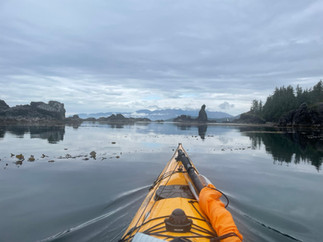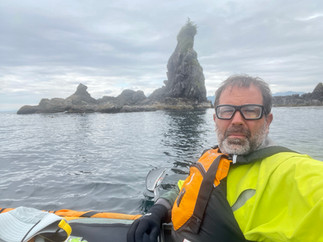PART 5 - Jul. 4th - Day 36 - Sea Kayak Vancouver Island Circumnavigation
- Felipe Behrens
- Jun 4, 2023
- 4 min read
Updated: Dec 5, 2023

More unbelievably calm conditions We paddled through a maze of sea stacks and boulders scattered along the coast like Lego pieces, and the thick beds of bull kelp that subdued the swells but hung to our kayaks like blotting paper. These thick kelp mattresses protecting the coast are a sign that sea otters must live in these areas as they are voracious consumers of sea urchins and clams that feed on the kelp.
“When the sea otters were hunted and extinguished in British Columbia, the kelp all but disappeared as the sea urchins ate them all up. That left the coastline exposed and towns got flooded during big winter storms.” Said JF.
“Then the otters were reintroduced in the 1970s. Canada imported one family from Alaska. They took hold here in Checleset Bay and then spread all along the coast, and behold, the kelp came back.”
As we paddled through the kelp, we caught sight of one of the local otters. Usually, the encounter with the otter follows a predictable pattern. It hears you coming from a fair distance as the animal has an acute sense of hearing and pokes its head out of the water as high as it can to establish what you are. Once it is satisfied that you are not some oddly colored Killer Whale it normally loses interest and goes about its business catching more shellfish to eat. On this encounter, however, something must have really upset the otter as even though we were a considerable distance away, it kept making a constant and acute squeak that could be heard long after we were gone.
“Very unusual.” Said JF. “Perhaps there was some other animal nearby that was bothering it that we did not see. I’ve heard that killer whales sometimes eat them.”
Given that I’ve already had a close encounter with a Killer Whale that had snuck up on me like a cheetah stalking a gazelle, I would not doubt that perhaps another had snuck up on us and only the keen sea otter had noticed.
“I can’t imagine that a sea otter must be very good tasting.” I said. “The thing is almost all fur, and for the killer whale it must be like swallowing a hairball.”
“Perhaps it’s an exotic delicacy. Killer whales are very fussy eaters and probably only a few hunt sea otters. I heard that killer whales that hunt Gray Whales only eat the tongue and leave the carcass for the sharks.”
“Well, I can relate to the killer whales, we are both fussy eaters.” I joked.
“Yeah, the opposite of the sea otter which eats almost anything. Perhaps we should have given it one of our onions. Maybe, like you, the killer whales won’t like onions with their food.”
We made camp at an archipelago called the Bunsby Islands where the narrow gaps between the islets create strong tidal currents. It was still early in the day, and JF went fishing along with two others while I, Justine and a group of three went to explore the water maze created by the rising water.
Later when we regrouped at camp JF was euphoric. “Phillip nearly caught a fifty-pound halibut!” he yelled as we paddled into camp.
Apparently, the story went something like this; JF, Phillip and Jerry had paddled to Cautious Point some ten minutes from the campsite. Phillip was a newbie to kayak fishing and JF spent a few minutes explaining to him the right technique.
“Find a reasonably calm spot, then put your paddle under the deck straps for stability. Then, when you cast the lure in the water and keep giving a few gentle tugs so it stays lively and entices the fish to bite. When you catch one, reel it in and then smack it with the wood club to stun it.”
Phillip cast the lure some ten feet from the boat and gave it some line to allow it to sink and started giving it the tugs. Barely a minute later, he felt a powerful pull on the line, and the fishing rod was bent into a U-shape.
“I think I got something.” He said.
As he reeled in the line the kayak began drifting, slowly at first, and then with so much violence that Jerry braced on to Phillip’s kayak so he wouldn’t tip over. When the fish briefly broke through the surface it became evident that they were dealing with something too large to fit into the kayak or stun with a small wooden club and would have to try and land the creature to overpower it. JF tied a tow rope to Jerry’s kayak, and began a tug of war with the fish, who, motivated by its survival instinct, was putting up a tremendous fight.
After twenty minutes the three made it to the beach. The beast was tiring faster than they were but only just.. JF was getting off his boat to pull the fish onto the shallow water where it could be man handled and its fate sealed, when suddenly there was a loud thump.
“It got away!” Jerry shouted as the line on Phillip’s rod snapped. The tension of the moment evaporated and suddenly all was quiet.
“Did you at least get a picture?” I asked with some doubt. Two days ago, JF had said a twenty-pound salmon had gotten away as well.
“Yes, we did.” He showed me a photograph of Phillip on his kayak holding the bent rod while Jerry braced the boat. “You can’t see the fish very well, but it’s the white smudge on the water by the kayak. I swear to God, there was easily a thousand dollars’ worth of flesh on that fish. The Halibut is fish that sports fishermen in the Pacific Northwest fantasize about catching. In my whole life I’ve never caught one.”
“Oh, it’s a great photo!” I said jokingly. “I’d up the size of the halibut to a hundred pounds based on the size of that smudge, and . say that Phillip has a fishing tale for the ages.”
Sea Kayak Vancouver Island Circumnavigation












Comentarios